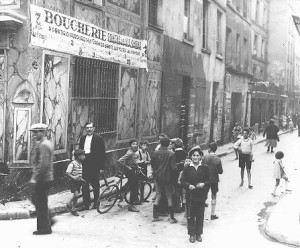by Stanley Meisler
The mass migrations of European peoples to this country in the late 19th and 20th centuries have become such clichéd events in American history that we often forget that the United States was not the only refuge for the emigration. Since American immigration was almost completely unrestricted, it made sense for most emigrants to head there. But France and Britain also accepted a limited number.
The great Russian Jewish migration, and France’s small role as a refuge, form a backdrop to my book Shocking Paris: Soutine, Chagall, and the Outsiders of Paris. The book relates the story of the School of Paris —- the immigrant painters who dominated the Paris art bazaar between the two world wars. Many came to France from the Russian empire during the great migration, and most were Jewish. In fact, it seemed like a star-blessed coincidence to discover that Soutine and my father left the Russian empire in the same year, 1913, Soutine to study art in Paris, my 14-year-old father to live with an older brother’s family in New York.
Although this played no role in my story, I also absorbed a great deal of information about the migration to France because of the meticulous and fascinating research of my son Joshua Meisler. He has spent more than a decade recreating the life of my father’s oldest brother, Dr. Hona Maisler (cq). Uncle Hona and his wife Khinia, both doctors in Paris who had emigrated from the Russian empire many decades earlier, were murdered in Auschwitz. The surviving family in the US knew little about them. Joshua’s research has rescued them from oblivion.
The flight of Russian Jews interested in medicine is a special feature of the great migration. I do not have the figures but there is no doubt about their presence. After all, almost every doctor consulted by the ailing Chaim Soutine in my book has an East European Jewish name. My uncle set no precedent by studying medicine in France.

Street scene in Jewish quarter of Paris during 1941. Image in the public domain via Yad Vashem.
The great migration from the Russian empire was forced by a series of pogroms at the turn of the 20th century in which Christian neighbors beat and killed hundreds of Jews. Many of these pogroms were evidently staged or at least encouraged by the Czarist governments, especially after the 1905 Revolution. Rather than condemn Czarist Russia’s lack of democracy and lack of justice for its troubles, the Czar and his court hunted for scapegoats. The Jews were obvious victims.
For those interested in medicine, moreover, there was a further incentive to leave. The academic road to a degree in medicine was largely blocked by an oppressive quota system. The quotas were introduced in 1887 after Russians became upset over the numbers of Jews in medicine, law and journalism. The ministry of education ruled that only 3% of the places in the secondary schools and universities of St. Petersburg and Moscow could be allotted to Jews. Some institutions closed their doors to all Jews. Jews outnumbered other peoples in the towns of the Pale of Settlement — the area where Jews were officially allowed to live outside the Russian heartland — yet only 10% of the places in secondary schools and universities were open to them. Future doctors like my uncle and aunt had little choice but to study in France.
My uncle did not become wealthy in Paris. He specialized in treating gonorrhea — not known as an ailment of the rich. But in the era before penicillin and other antibiotics, he developed a treatment known as Maislériase that alleviated most of the symptoms. He was highly respected and was compensated enough to own an apartment and laboratory in Paris and a small weekend home near the castle and forest of Fontainebleau.
Like the painters in the book, my uncle, aunt and the other Jewish immigrant doctors were betrayed by two terrible failings of France. First, its army, once touted as the most powerful in Europe, was trounced in a few short weeks by Hitler’s troops in World War II, and then its government fell into the hands of right-wing, collaborationist, anti-Semitic politicians.
Stanley Meisler is an emeritus foreign correspondent for the Los Angeles Times. He is a distant relation (by marriage) of Chaim Soutine and has written several articles on Soutine and the School of Paris for the Smithsonian and the Los Angeles Times. He lives in Washington, DC.
